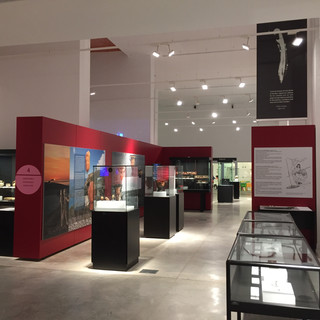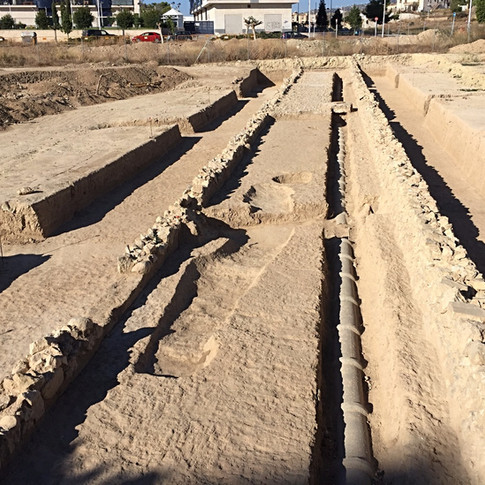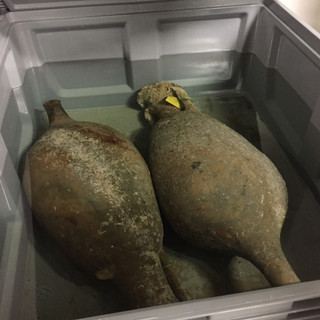What did the Romans ever do for Villajoyosa?
Quite a lot, as it happens. But the Romans weren't the first to realise that Villajoyosa might be a nice place to settle. People had been living in and around La Vila for thousands of years before the Romans got around to creating their empire. You can find clues to Villajoyosa's ancient history all along the coast -- and even out at sea.
The Phoenicians came here to trade from present-day Syria and Lebanon 800 years before Christ. The Greeks knew it as Alonis well before the Romans built their town of Allon here.
The best place to start looking at La Vila's ancient history is the town museum on Calle Colón (above), which has some beautiful exhibits which wouldn’t look out of place in much bigger museums.
Even the museum building is unusual: it’s a brand new structure built behind the façade of the old town school (above). Try to catch one of the guided tours; they are in English as well as Spanish.
Among the exhibits unearthed locally is an exquisite Phoenician gold necklace (above), an Egyptian perfume jar and a beautiful 2,500 year old Egyptian flask used for flood water taken from the River Nile, believed to have had magical curative properties.
The flask was discovered by archaeologists at a cemetery in Les Casetes, in the Creuta area of La Vila. You can see some stonework from the cemetery in the nearby Barbera dels Aragones gardens.
Some of the other finds on display (including the necklace) came from another cemetery excavated in Poble Nou, across the river Amadorio bridge, now the site of a Mercadona supermarket on Carrer Jaume 1. Helpful explanatory plaques on the street show you the exact location. Archaeologists found tombs there dating from 700 years BC to the end of the Roman Empire. A third cemetery was excavated in 2015 in the Palasiet area of La Vila, not far from our apartment.
There's more evidence of ancient settlements at Malladeta, on the southern outskirts of La Vila. Head for the ruined 19th century tower on the cliff and the excavations are just below. Ancient Iberian people had a shrine here, built in the 4th century BC. At the spring and autumn equinoxes, they gathered to see the sun rise behind the Islote de Benidorm (the small island off Benidorm). Both dates were key times in their agricultural year.
The little bronze guy below is one of my favourites from La Vila museum; he was an offering to the gods in the 2nd century BC, found at Malladeta.
The rooms at the shrine were abandoned around 25 BC, according to the info plaque on site, although a temple remained at the top of the hill where the ruined tower now stands. The whole site was abandoned by 80 AD, when the cult moved into the forum of Allon, which had been declared a municipium (Roman town) by the Emperor Vespasian.
The Romans made Allon their most important town in the Marina Baixa area. No self-respecting Roman would go without his regular bath, so they built a baths complex on present-day Carrer Canalejas which were excavated in 2006 (pic below, source Vilamuseu). Sadly, the remains aren't open to the public and you can only peek through the fence at a rather uninspiring mound of rubble and weeds.
Wealthy Romans had villas outside the town of Allon. On show in La Vila museum are fragments of mosaic floors excavated from the villa of Xauxelles near the village of La Ermita. To see even more, head to the impressive MARQ (archaeological museum) in Alicante where you'll see finds not only from La Vila, but the whole region. Well worth a visit.
A Roman road ran through Allon along the coast; you can see part of it, excavated in 2017 on the site of a new housing development near Malladeta on the southern edge of La Vila (above).
In all likelihood, the Roman road then headed up towards present-day Benidorm. Head out of town in that direction to Playa de Torres to find the remarkable Torre de Sant Josep (below). It's a five minute drive or a 45 minute walk along the cliffs from La Vila.
A Roman funeral tower, built during the reign of the Emperor Hadrian, the Torre de Sant Josep is the largest of only three such towers in the whole Iberian peninsula.
The tower has just been restored to the way it might have looked when it was first built between 150-170 AD, complete with surrounding gardens (though the tower had a pyramid on top originally).
Nobody knows for sure who was buried here, though archaeologists have found a stone inscription of someone called Lucio Terencio Mancino. If such an imposing tower really was built for him, old Lucio must have been a seriously big cheese in Allon at the time.
Perhaps the most remarkable Roman find of all is actually on the sea bed out in the bay, 25 metres under the waves. The wreck of a Roman cargo vessel, named the Bou Ferrer after the two divers who discovered it, lies about a kilometre offshore.
The ship was probably heading for Rome when it sank in a storm off La Vila in the mid 1st century AD, most likely in the reign of the Emperor Nero. On board were 3,000 Roman amphorae (storage jars) containing fish sauce from Cadiz, then a highly prized delicacy. The Bou Ferrer was also carrying ingots of lead; perhaps not an ideal cargo for a ship in trouble in stormy weather. The wreck is one of the most important finds of its kind in the entire Mediterranean.
A lot of the preservation work is being done at La Vila museum; try to catch one of their fascinating Bou Ferrer tours. You get to handle the amphorae, see a lead ingot salvaged from the wreck, and hear how the finds from the wreck are being preserved in the museum laboratories (above).
See an interactive map of the Bou Ferrer's likely route here. There are some great pictures on this video showing divers at work on the ship. If you're a sub-aqua diver yourself, there are guided tours to the wreck organised by Ali-Sub in Villajoyosa marina. Link here
Click here for more posts about Villajoyosa, or to rent our beautiful seafront apartment, click here



































